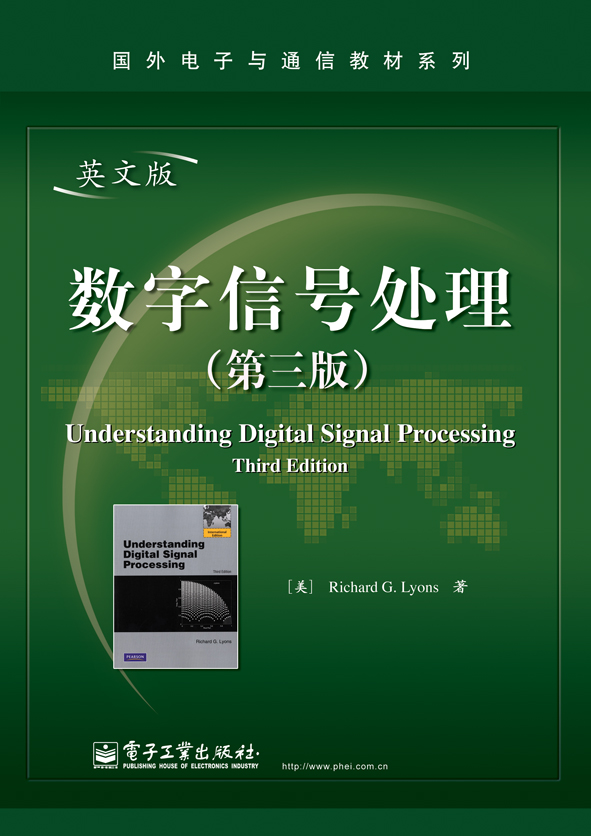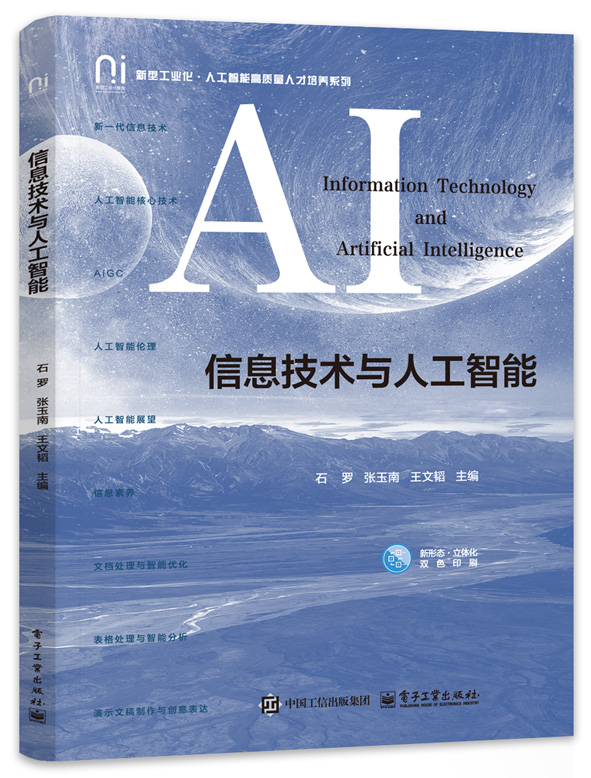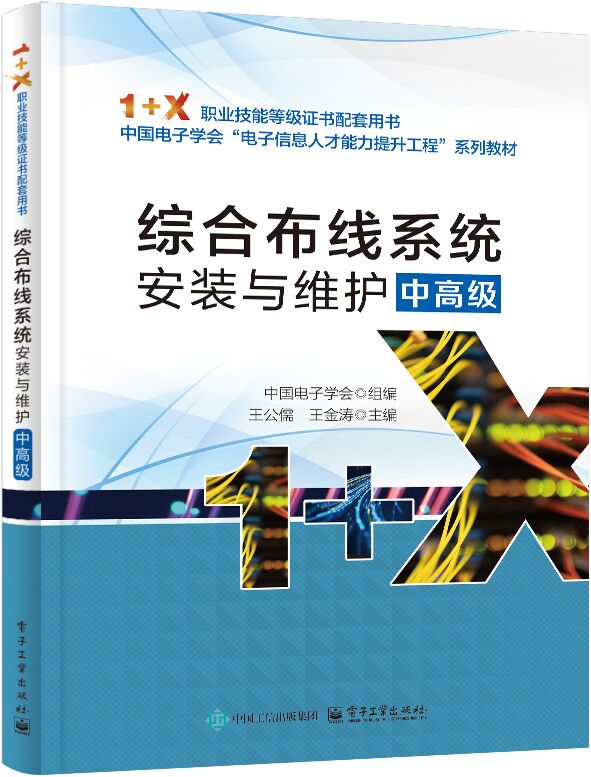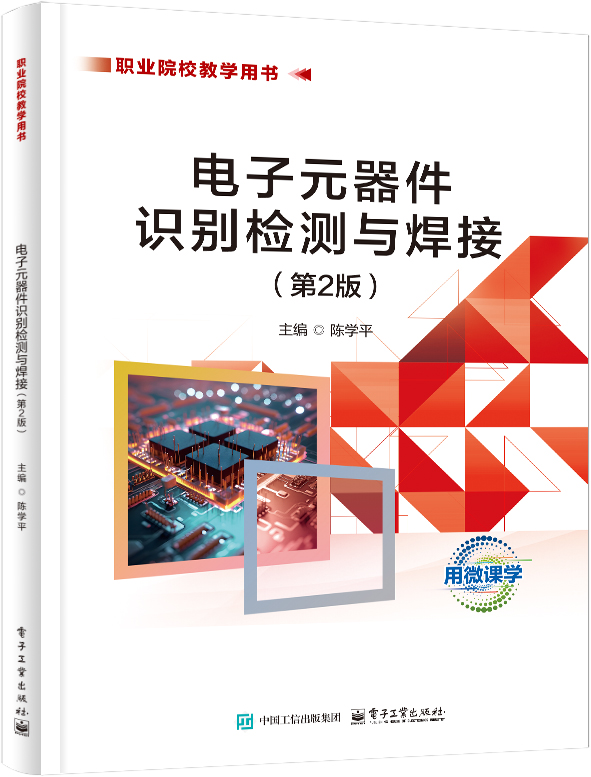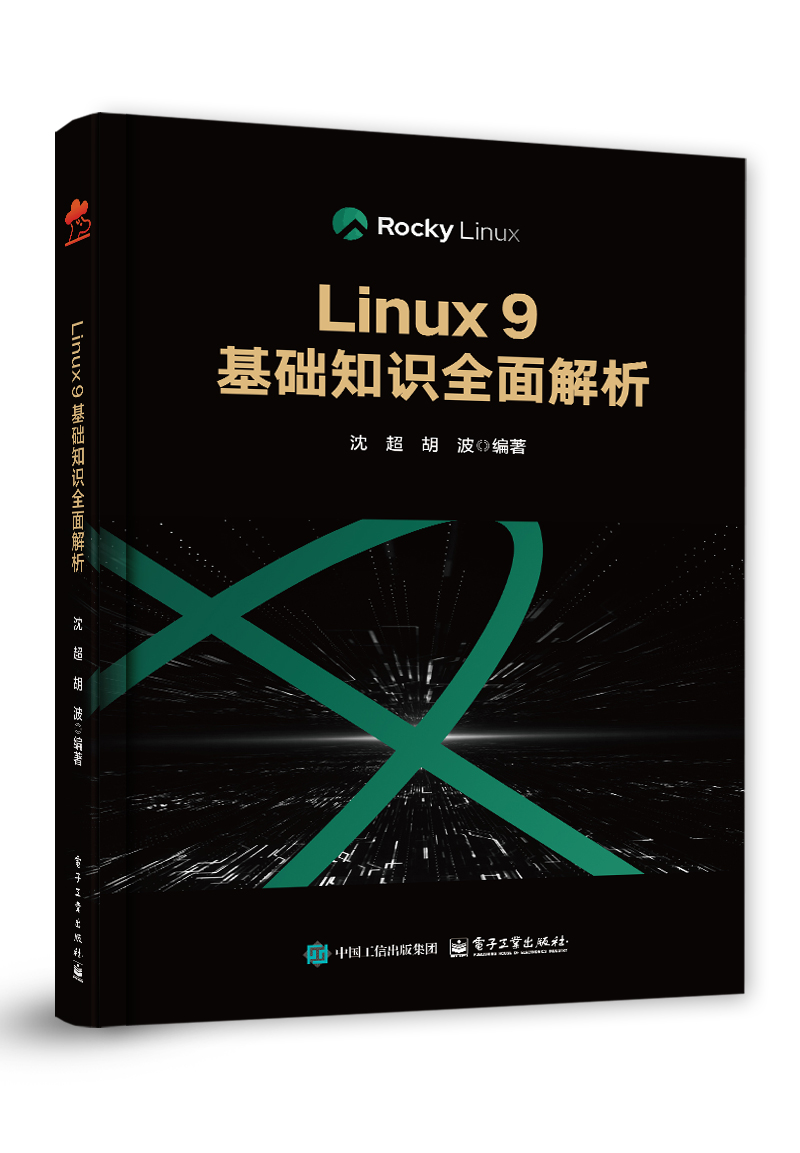数字信号处理(第三版)(英文版)
作 译 者:理查德 G. 莱昂斯
出 版 日 期:2012-08-01
书 代 号:G0176120
I S B N:9787121176128
图书简介:
本书可供英文原版教辅:PPT;教辅申请咨询Email:Te_service@phei.com.cn。本书全面讨论了数字信号处理的基本概念、原理和应用。全书共13章,主要包括离散序列和系统、离散傅里叶变换和其快速算法、有限和无限脉冲响应的滤波器的设计基本原理的基本数字信号处理内容,另外包括数字网络和滤波器、离散希尔伯特变换、抽样率的变换和信号平均、信号数字化及其影响的专业信号处理内容。给出了多年总结出的数字信号处理的一些技巧,包括如何进行复数的快速乘法、实序列的FFT变换、使用FFT的FIR滤波器设计等。附录对数字信号处理涉及的数学知识和术语给出了详细介绍和总结。相比于前版,本书每章都新增了部分内容,并附了习题,便于读者的自学。
定价 79.0
您的专属联系人更多
联系人:马老师
电话:4557
邮箱:malan@phei.com
-
配 套 资 源
-
图 书 内 容
内容简介
本书可供英文原版教辅:PPT;教辅申请咨询Email:Te_service@phei.com.cn。 本书全面讨论了数字信号处理的基本概念、原理和应用。全书共13章,主要包括离散序列和系统、离散傅里叶变换和其快速算法、有限和无限脉冲响应的滤波器的设计基本原理的基本数字信号处理内容,另外包括数字网络和滤波器、离散希尔伯特变换、抽样率的变换和信号平均、信号数字化及其影响的专业信号处理内容。给出了多年总结出的数字信号处理的一些技巧,包括如何进行复数的快速乘法、实序列的FFT变换、使用FFT的FIR滤波器设计等。附录对数字信号处理涉及的数学知识和术语给出了详细介绍和总结。相比于前版,本书每章都新增了部分内容,并附了习题,便于读者的自学。图书详情
ISBN:9787121176128开 本:16开页 数:616字 数:1281本书目录
Chapter 1 Discrete Sequences and Systems 1.1 DISCRETE SEQUENCES AND THEIR NOTATION 1.2 SIGNAL AMPLITUDE, MAGNITUDE, POWER 1.3 SIGNAL PROCESSING OPERATIONAL SYMBOLS 1.4 INTRODUCTION TO DISCRETE LINEAR TIME-INVARIANT SYSTEMS 1.5 DISCRETE LINEAR SYSTEMS 1.5.1 Example of a Linear System 1.5.2 Example of a Nonlinear System 1.6 TIME-INVARIANT SYSTEMS 1.6.1 Example of a Time-Invariant System 1.7 THE COMMUTATIVE PROPERTY OF LINEAR TIME-INVARIANT SYSTEMS 1.8 ANALYZING LINEAR TIME-INVARIANT SYSTEMS REFERENCES CHAPTER 1 PROBLEMS Chapter 2 Periodic Sampling 2.1 ALIASING: SIGNALAMBIGUITY IN THE FREQUENCY DOMAIN 2.2 SAMPLING LOWPASS SIGNALS 2.3 SAMPLING BANDPASS SIGNALS 2.4 PRACTICAL ASPECTS OF BANDPASS SAMPLING 2.4.1 Spectral Inversion in Bandpass Sampling 2.4.2 Positioning Sampled Spectra at fs/4 2.4.3 Noise in Bandpass-Sampled Signals REFERENCES CHAPTER 2 PROBLEMS CHAPTER 3 The Discrete Fourier Transform 3.1 UNDERSTANDING THE DFT EQUATION 3.1.1 DFT Example 3.2 DFT SYMMETRY 3.3 DFT LINEARITY 3.4 DFT MAGNITUDES 3.5 DFT FREQUENCY AXIS 3.6 DFT SHIFTING THEOREM 3.6.1 DFT Example 2 3.7 INVERSE DFT 3.8 DFT LEAKAGE 3.9 WINDOWS 3.10 DFT SCALLOPING LOSS 3.11 DFT RESOLUTION, ZERO PADDING, AND FREQUENCY-DOMAIN SAMPLING 3.12 DFT PROCESSING GAIN 3.12.1 Processing Gain of a Single DFT 3.12.2 Integration Gain Due to Averaging Multiple DFTs 3.13 THE DFT OF RECTANGULAR FUNCTIONS 3.13.1 DFT of a General Rectangular Function 3.13.2 DFT of a Symmetrical Rectangular Function 3.13.3 DFT of an All-Ones Rectangular Function 3.13.4 Time and Frequency Axes Associated with the DFT 3.13.5 Alternate Form of the DFT of an All-Ones Rectangular Function 3.14 INTERPRETING THE DFT USING THE DISCRETE-TIME FOURIER TRANSFORM REFERENCES CHAPTER 3 PROBLEMS Chapter 4 The Fast Fourier Transform 4.1 RELATIONSHIP OF THE FFT TO THE DFT 4.2 HINTS ON USING FFTS IN PRACTICE 4.2.1 Sample Fast Enough and Long Enough 4.2.2 Manipulating the Time Data Prior to Transformation 4.2.3 Enhancing FFT Results 4.2.4 Interpreting FFT Results 4.3 DERIVATION OF THE RADIX-2 FFT ALGORITHM 4.4 FFT INPUT/OUTPUT DATA INDEX BIT REVERSAL 4.5 RADIX-2 FFT BUTTERFLY STRUCTURES 4.6 ALTERNATE SINGLE-BUTTERFLY STRUCTURES REFERENCES CHAPTER 4 PROBLEMS Chapter 5 Finite Impulse Response Filters 5.1 AN INTRODUCTION TO FINITE IMPULSE RESPONSE (FIR) FILTERS 5.2 CONVOLUTION IN FIR FILTERS 5.3 LOWPASS FIR FILTER DESIGN 5.3.1 Window Design Method 5.3.2 Windows Used in FIR Filter Design 5.4 BANDPASS FIR FILTER DESIGN 5.5 HIGHPASS FIR FILTER DESIGN 5.6 PARKS-MCCLELLAN EXCHANGE FIR FILTER DESIGN METHOD 5.7 HALF-BAND FIR FILTERS 5.8 PHASE RESPONSE OF FIR FILTERS 5.9 A GENERIC DESCRIPTION OF DISCRETE CONVOLUTION 5.9.1 Discrete Convolution in the Time Domain 5.9.2 The Convolution Theorem 5.9.3 Applying the Convolution Theorem 5.10 ANALYZING FIR FILTERS 5.10.1 Algebraic Analysis of FIR Filters 5.10.2 DFT Analysis of FIR Filters 5.10.3 FIR Filter Group Delay Revisited 5.10.4 FIR Filter Passband Gain 5.10.5 Estimating the Number of FIR Filter Taps REFERENCES CHAPTER 5 PROBLEMS Chapter 6 Infinite Impulse Response Filters 6.1 AN INTRODUCTION TO INFINITE IMPULSE RESPONSE FILTERS 6.2 THE LAPLACE TRANSFORM 6.2.1 Poles and Zeros on the s-Plane and Stability 6.3 THE z -TRANSFORM 6.3.1 Poles, Zeros, and Digital Filter Stability 6.4 USING THE z -TRANSFORM TO ANALYZE IIR FILTERS 6.4.1 z -Domain IIR Filter Analysis 6.4.2 IIR Filter Analysis Example 6.5 USING POLES AND ZEROS TO ANALYZE IIR FILTERS 6.5.1 IIR Filter Transfer Function Algebra 6.5.2 Using Poles/Zeros to Obtain Transfer Functions 6.6 ALTERNATE IIR FILTER STRUCTURES 6.6.1 Direct Form I, Direct Form II, and Transposed Structures 6.6.2 The Transposition Theorem 6.7 PITFALLS IN BUILDING IIR FILTERS 6.8 IMPROVING IIR FILTERS WITH CASCADED STRUCTURES 6.8.1 Cascade and Parallel Filter Properties 6.8.2 Cascading IIR Filters 6.9 SCALING THE GAIN OF IIR FILTERS 6.10 IMPULSE INVARIANCE IIR FILTER DESIGN METHOD 6.10.1 Impulse Invariance Design Method 1 Example 6.10.2 Impulse Invariance Design Method 2 Example 6.11 BILINEAR TRANSFORM IIR FILTER DESIGN METHOD 6.11.1 Bilinear Transform Design Example 6.12 OPTIMIZED IIR FILTER DESIGN METHOD 6.13 A BRIEF COMPARISON OF IIR AND FIR FILTERS REFERENCES CHAPTER 6 PROBLEMS Chapter 7 Specialized Digital Networks and Filters 7.1 DIFFERENTIATORS 7.1.1 Simple Differentiators 7.1.2 Specialized Narrowband Differentiators 7.1.3 Wideband Differentiators 7.1.4 Optimized Wideband Differentiators 7.2 INTEGRATORS 7.2.1 Rectangular Rule Integrator 7.2.2 Trapezoidal Rule Integrator 7.2.3 Simpson’s Rule Integrator 7.2.4 Tick’s Rule Integrator 7.2.5 Integrator Performance Comparison 7.3 MATCHED FILTERS 7.3.1 Matched Filter Properties 7.3.2 Matched Filter Example 7.3.3 Matched Filter Implementation Considerations 7.4 INTERPOLATED LOWPASS FIR FILTERS 7.4.1 Choosing the Optimum Expansion Factor M 7.4.2 Estimating the Number of FIR Filter Taps 7.4.3 Modeling IFIR Filter Performance 7.4.4 IFIR Filter Implementation Issues 7.4.5 IFIR Filter Design Example 7.5 FREQUENCY SAMPLING FILTERS: THE LOSTART 7.5.1 Comb Filter and Complex Resonator in Cascade 7.5.2 Multisection Complex FSFs 7.5.3 Ensuring FSF Stability 7.5.4 Multisection Real-Valued FSFs 7.5.5 Linear-Phase Multisection Real-Valued FSFs 7.5.6 Where We’ve Been and Where We’re Going with FSFs 7.5.7 An Efficient Real-Valued FSF 7.5.8 Modeling FSFs 7.5.9 Improving Performance with Transition Band Coefficients 7.5.10 Alternate FSF Structures 7.5.11 The Merits of FSFs 7.5.12 Type-IV FSF Example 7.5.13 When to Use an FSF 7.5.14 Designing FSFs 7.5.15 FSF Summary REFERENCES CHAPTER 7 PROBLEMS Chapter 8 Quadrature Signals 8.1 WHY CARE ABOUT QUADRATURE SIGNALS? 8.2 THE NOTATION OF COMPLEX NUMBERS 8.3 REPRESENTING REAL SIGNALS USING COMPLEX PHASORS 8.4 A FEW THOUGHTS ON NEGATIVE FREQUENCY 8.5 QUADRATURE SIGNALS IN THE FREQUENCY DOMAIN 8.6 BANDPASS QUADRATURE SIGNALS IN THE FREQUENCY DOMAIN 8.7 COMPLEX DOWN-CONVERSION 8.8 A COMPLEX DOWN-CONVERSION EXAMPLE 8.9 AN ALTERNATE DOWN-CONVERSION METHOD REFERENCES CHAPTER 8 PROBLEMS Chapter 9 The Discrete Hilbert Transform 9.1 HILBERT TRANSFORM DEFINITION 9.2 WHY CARE ABOUT THE HILBERT TRANSFORM? 9.3 IMPULSE RESPONSE OF A HILBERT TRANSFORMER 9.4 DESIGNING A DISCRETE HILBERT TRANSFORMER 9.4.1 Time-Domain Hilbert Transformation: FIR Filter Implementation 9.4.2 Frequency-Domain Hilbert Transformation 9.5 TIME-DOMAIN ANALYTIC SIGNAL GENERATION 9.6 COMPARING ANALYTIC SIGNAL GENERATION METHODS REFERENCES CHAPTER 9 PROBLEMS Chapter 10 Sample Rate Conversion 10.1 DECIMATION 10.2 TWO-STAGE DECIMATION 10.2.1 Two-Stage Decimation Concepts 10.2.2 Two-Stage Decimation Example 10.2.3 Two-Stage Decimation Considerations 10.3 PROPERTIES OF DOWNSAMPLING 10.3.1 Time and Frequency Properties of Downsampling 10.3.2 Drawing Downsampled Spectra 10.4 INTERPOLATION 10.5 PROPERTIES OF INTERPOLATION 10.5.1 Time and Frequency Properties of Interpolation 10.5.2 Drawing Upsampled Spectra 10.6 COMBINING DECIMATION AND INTERPOLATION 10.7 POLYPHASE FILTERS 10.8 TWO-STAGE INTERPOLATION 10.8.1 Two-Stage Interpolation Concepts 10.8.2 Two-Stage Interpolation Example 10.8.3 Two-Stage Interpolation Considerations 10.9 z-TRANSFORM ANALYSIS OF MULTIRATE SYSTEMS 10.9.1 Signal Mathematical Notation 10.9.2 Filter Mathematical Notation 10.10 POLYPHASE FILTER IMPLEMENTATIONS 10.11 SAMPLE RATE CONVERSION BY RATIONAL FACTORS 10.12 SAMPLE RATE CONVERSION WITH HALF-BAND FILTERS 10.12.1 Half-band Filtering Fundamentals 10.12.2 Half-band Filter Implementations 10.13 SAMPLE RATE CONVERSION WITH IFIR FILTERS 10.14 CASCADED INTEGRATOR-COMB FILTERS 10.14.1 Recursive Running Sum Filter 10.14.2 CIC Filter Structures 10.14.3 Improving CIC Attenuation 10.14.4 CIC Filter Implementation Issues 10.14.5 Compensation/Preconditioning FIR Filters REFERENCES CHAPTER 10 PROBLEMS Chapter 11 Signal Averaging 11.1 COHERENT AVERAGING 11.2 INCOHERENT AVERAGING 11.3 AVERAGING MULTIPLE FAST FOURIER TRANSFORMS 11.4 AVERAGING PHASE ANGLES 11.5 FILTERING ASPECTS OF TIME-DOMAIN AVERAGING 11.6 EXPONENTIAL AVERAGING 11.6.1 Time-Domain Filter Behavior 11.6.2 Frequency-Domain Filter Behavior 11.6.3 Exponential Averager Application REFERENCES CHAPTER 11 PROBLEMS Chapter 12 Digital Data Formats and Their Effects 12.1 FIXED-POINT BINARY FORMATS 12.1.1 Octal Numbers 12.1.2 Hexadecimal Numbers 12.1.3 Sign-Magnitude Binary Format 12.1.4 Two’s Complement Format 12.1.5 Offset Binary Format 12.1.6 Fractional Binary Numbers 12.2 BINARY NUMBER PRECISION AND DYNAMIC RANGE 12.3 EFFECTS OF FINITE FIXED-POINT BINARY WORD LENGTH 12.3.1 A/D Converter Quantization Errors 12.3.2 Data Overflow 12.3.3 Truncation 12.3.4 Data Rounding 12.4 FLOATING-POINT BINARY FORMATS 12.4.1 Floating-Point Dynamic Range 12.5 BLOCK FLOATING-POINT BINARY FORMAT REFERENCES CHAPTER 12 PROBLEMS Chapter 13 Digital Signal Processing Tricks 13.1 FREQUENCY TRANSLATION WITHOUT MULTIPLICATION 13.1.1 Frequency Translation by fs/2 13.1.2 Frequency Translation by –fs/4 13.1.3 Filtering and Decimation after fs/4 Down-Conversion 13.2 HIGH-SPEED VECTOR MAGNITUDE APPROXIMATION 13.3 FREQUENCY-DOMAIN WINDOWING 13.4 FAST MULTIPLICATION OF COMPLEX NUMBERS 13.5 EFFICIENTLY PERFORMING THE FFT OF REAL SEQUENCES 13.5.1 Performing Two N-Point Real FFTs 13.5.2 Performing a 2N-Point Real FFT 13.6 COMPUTING THE INVERSE FFT USING THE FORWARD FFT 13.6.1 Inverse FFT Method 1 13.6.2 Inverse FFT Method 2 13.7 SIMPLIFIED FIR FILTER STRUCTURE 13.8 REDUCING A/D CONVERTER QUANTIZATION NOISE 13.8.1 Oversampling 13.8.2 Dithering 13.9 A/D CONVERTER TESTING TECHNIQUES 13.9.1 Estimating A/D Quantization Noise with the FFT 13.9.2 Estimating A/D Dynamic Range 13.9.3 Detecting Missing Codes 13.10 FAST FIR FILTERING USING THE FFT 13.11 GENERATING NORMALLY DISTRIBUTED RANDOM DATA 13.12 ZERO-PHASE FILTERING 13.13 SHARPENED FIR FILTERS 13.14 INTERPOLATING A BANDPASS SIGNAL 13.15 SPECTRAL PEAK LOCATION ALGORITHM 13.16 COMPUTING FFT TWIDDLE FACTORS 13.16.1 Decimation-in-Frequency FFT Twiddle Factors 13.16.2 Decimation-in-Time FFT Twiddle Factors 13.17 SINGLE TONE DETECTION 13.17.1 Goertzel Algorithm 13.17.2 Goertzel Example 13.17.3 Goertzel Advantages over the FFT 13.18 THE SLIDING DFT 13.18.1 The Sliding DFT Algorithm 13.18.2 SDFT Stability 13.18.3 SDFT Leakage Reduction 13.18.4 A Little-Known SDFT Property 13.19 THE ZOOM FFT 13.20 A PRACTICAL SPECTRUM ANALYZER 13.21 AN EFFICIENT ARCTANGENT APPROXIMATION 13.22 FREQUENCY DEMODULATION ALGORITHMS 13.23 DC REMOVAL 13.23.1 Block-Data DC Removal 13.23.2 Real-Time DC Removal 13.23.3 Real-Time DC Removal with Quantization 13.24 IMPROVING TRADITIONAL CIC FILTERS 13.24.1 Nonrecursive CIC Filters 13.24.2 Nonrecursive Prime-Factor-R CIC Filters 13.25 SMOOTHING IMPULSIVE NOISE 13.26 EFFICIENT POLYNOMIAL EVALUATION 13.26.1 Floating-Point Horner’s Rule 13.26.2 Horner’s Rule in Binary Shift Multiplication/Division 13.26.3 Estrin’s Method 13.27 DESIGNING VERY HIGH-ORDER FIR FILTERS 13.28 TIME-DOMAIN INTERPOLATION USING THE FFT 13.28.1 Computing Interpolated Real Signals 13.28.2 Computing Interpolated Analytic Signals 13.29 FREQUENCY TRANSLATION USING DECIMATION 13.29.1 Translation of Real Signals Using Decimation 13.29.2 Translation of Complex Signals Using Decimation 13.30 AUTOMATIC GAIN CONTROL (AGC) 13.31 APPROXIMATE ENVELOPE DETECTION 13.32 A QUADRATURE OSCILLATOR 13.33 SPECIALIZED EXPONENTIALAVERAGING 13.33.1 Single-Multiply Exponential Averaging 13.33.2 Multiplier-Free Exponential Averaging 13.33.3 Dual-Mode Averaging 13.34 FILTERING NARROWBAND NOISE USING FILTER NULLS 13.35 EFFICIENT COMPUTATION OF SIGNALVARIANCE 13.36 REAL-TIME COMPUTATION OF SIGNAL AVERAGES AND VARIANCES 13.36.1 Computing Moving Averages and Variances 13.36.2 Computing Exponential Moving Average and Variance 13.37 BUILDING HILBERT TRANSFORMERS FROM HALF-BAND FILTERS 13.37.1 Half-band Filter Frequency Translation 13.37.2 Half-band Filter Coefficient Modification 13.38 COMPLEX VECTOR ROTATION WITH ARCTANGENTS 13.38.1 Vector Rotation to the 1st Octant 13.38.2 Vector Rotation by ±π/8 13.39 AN EFFICIENT DIFFERENTIATING NETWORK 13.40 LINEAR-PHASE DC-REMOVAL FILTER 13.41 AVOIDING OVERFLOW IN MAGNITUDE COMPUTATIONS 13.42 EFFICIENT LINEAR INTERPOLATION 13.43 ALTERNATE COMPLEX DOWN-CONVERSION SCHEMES 13.43.1 Half-band Filter Down-conversion 13.43.2 Efficient Single-Decimation Down-conversion 13.44 SIGNAL TRANSITION DETECTION 13.45 SPECTRAL FLIPPING AROUND SIGNAL CENTER FREQUENCY 13.46 COMPUTING MISSING SIGNAL SAMPLES 13.47 COMPUTING LARGE DFTS USING SMALL FFTS 13.48 COMPUTING FILTER GROUP DELAY WITHOUT ARCTANGENTS 13.49 COMPUTING A FORWARD AND INVERSE FFT USING A SINGLE FFT 13.50 IMPROVED NARROWBAND LOWPASS IIR FILTERS 13.50.1 The Problem with Narrowband Lowpass IIR Filters 13.50.2 An Improved Narrowband Lowpass IIR Filter 13.50.3 Interpolated-IIR Filter Example 13.51 A STABLE GOERTZEL ALGORITHM REFERENCES Appendix A The Arithmetic of Complex Numbers Appendix B Closed Form of a Geometric Series Appendix C Time Reversal and the DFT Appendix D Mean, Variance, and Standard Deviation Appendix E Decibels (dB and dBm) Appendix F Digital Filter Terminology Appendix G Frequency Sampling Filter Derivations Appendix H Frequency Sampling Filter Design Tables Appendix I Computing Chebyshev Window Sequences展开前 言
Preface This book is an expansion of previous editions of Understanding Digital Signal Processing. Like those earlier editions, its goals are (1) to help beginning students understand the theory of digital signal processing (DSP) and (2) to provide practical DSP information, not found in other books, to help working engineers/scientists design and test their signal processing systems. Each chapter of this book contains new information beyond that provided in earlier editions. It’s traditional at this point in the preface of a DSP textbook for the author to tell readers why they should learn DSP. I don’t need to tell you how important DSP is in our modern engineering world. You already know that. I’ll just say that the future of electronics is DSP, and with this book you will not be left behind. FOR INSTRUCTORS This third edition is appropriate as the text for a one- or two-semester undergraduate course in DSP. It follows the DSP material I cover in my corporate training activities and a signal processing course I taught at the University of California Santa Cruz Extension. To aid students in their efforts to learn DSP, this third edition provides additional explanations and examples to increase its tutorial value. To test a student’s understanding of the material, homework problems have been included at the end of each chapter. (For qualified instructors, a Solutions Manual is available. Please contact your local Pearson office.) FOR PRACTICING ENGINEERS To help working DSP engineers, the changes in this third edition include, but are not limited to, the following: Practical guidance in building discrete differentiators, integrators, and matched filters Descriptions of statistical measures of signals, variance reduction by way of averaging, and techniques for computing real-world signal-to- noise ratios (SNRs) A significantly expanded chapter on sample rate conversion (multirate systems) and its associated filtering Implementing fast convolution (FIR filtering in the frequency domain) IIR filter scaling Enhanced material covering techniques for analyzing the behavior and performance of digital filters Expanded descriptions of industry-standard binary number formats used in modern processing systems Numerous additions to the popular “Digital Signal Processing Tricks” chapter FOR STUDENTS Learning the fundamentals, and how to speak the language, of digital signal processing does not require profound analytical skills or an extensive background in mathematics. All you need is a little experience with elementary algebra, knowledge of what a sinewave is, this book, and enthusiasm. This may sound hard to believe, particularly if you’ve just flipped through the pages of this book and seen figures and equations that look rather complicated. The content here, you say, looks suspiciously like material in technical journals and textbooks whose meaning has eluded you in the past. Well, this is not just another book on digital signal processing. In this book I provide a gentle, but thorough, explanation of the theory and practice of DSP. The text is not written so that you may understand the material, but so that you must understand the material. I’ve attempted to avoid the traditional instructor-student relationship and have tried to make reading this book seem like talking to a friend while walking in the park. I’ve used just enough mathematics to help you develop a fundamental understanding of DSP theory and have illustrated that theory with practical examples. I have designed the homework problems to be more than mere exercises that assign values to variables for the student to plug into some equation in order to compute a result. Instead, the homework problems are designed to be as educational as possible in the sense of expanding on and enabling further investigation of specific aspects of DSP topics covered in the text. Stated differently, the homework problems are not designed to induce “death by algebra” but rather to improve your understanding of DSP. Solving the problems helps you become proactive in your own DSP education instead of merely being an inactive recipient of DSP information. THE JOURNEY Learning digital signal processing is not something you accomplish; it’s a journey you take. When you gain an understanding of one topic, questions arise that cause you to investigate some other facet of digital signal processing. Armed with more knowledge, you’re likely to begin exploring further aspects of digital signal processing much like those shown in the diagram on page xviii. This book is your tour guide during the first steps of your journey. You don’t need a computer to learn the material in this book, but it would certainly help. DSP simulation software allows the beginner to verify signal processing theory through the time-tested trial and error process. In particular, software routines that plot signal data, perform the fast Fourier transforms, and analyze digital filters would be very useful. As you go through the material in this book, don’t be discouraged if your understanding comes slowly. As the Greek mathematician Menaechmus curtly remarked to Alexander the Great, when asked for a quick explanation of mathematics, There is no royal road to mathematics. Menaechmus was confident in telling Alexander the only way to learn mathematics is through careful study. The same applies to digital signal processing. Also, don’t worry if you need to read some of the material twice. While the concepts in this book are not as complicated as quantum physics, as mysterious as the lyrics of the song Louie Louie, or as puzzling as the assembly instructions of a metal shed, they can become a little involved. They deserve your thoughtful attention. So, go slowly and read the material twice if necessary; you’ll be glad you did. If you show persistence, to quote Susan B. Anthony, “Failure is impossible”. COMING ATTRACTIONS Chapter 1 begins by establishing the notation used throughout the remainder of the book. In that chapter we introduce the concept of discrete signal sequences, show how they relate to continuous signals, and illustrate how those sequences can be depicted in both the time and frequency domains. In addition, Chapter 1 defines the operational symbols we’ll use to build our signal processing system block diagrams. We conclude that chapter with a brief introduction to the idea of linear systems and see why linearity enables us to use a number of powerful mathematical tools in our analysis. Chapter 2 introduces the most frequently misunderstood process in digital signal processing, periodic sampling. Although the concept of sampling a continuous signal is not complicated, there are mathematical subtleties in the process that require thoughtful attention. Beginning gradually with simple examples of lowpass sampling, we then proceed to the interesting subject of bandpass sampling. Chapter 2 explains and quantifies the frequency-domain ambiguity (aliasing) associated with these important topics. Chapter 3 is devoted to one of the foremost topics in digital signal processing, the discrete Fourier transform (DFT) used for spectrum analysis. Coverage begins with detailed examples illustrating the important properties of the DFT and how to interpret DFT spectral results, progresses to the topic of windows used to reduce DFT leakage, and discusses the processing gain afforded by the DFT. The chapter concludes with a detailed discussion of the various forms of the transform of rectangular functions that the reader is likely to encounter in the literature. Chapter 4 covers the innovation that made the most profound impact on the field of digital signal processing, the fast Fourier transform (FFT). There we show the relationship of the popular radix-2 FFT to the DFT, quantify the powerful processing advantages gained by using the FFT, demonstrate why the FFT functions as it does, and present various FFT implementation structures. Chapter 4 also includes a list of recommendations to help the reader use the FFT in practice. Chapter 5 ushers in the subject of digital filtering. Beginning with a simple lowpass finite impulse response (FIR) filter example, we carefully progress through the analysis of that filter’s frequency-domain magnitude and phase response. Next, we learn how window functions affect, and can be used to design, FIR filters. The methods for converting lowpass FIR filter designs to bandpass and highpass digital filters are presented, and the popular Parks-McClellan (Remez) Exchange FIR filter design technique is introduced and illustrated by example. In that chapter we acquaint the reader with, and take the mystery out of, the process called convolution. Proceeding through several simple convolution examples, we conclude Chapter 5 with a discussion of the powerful convolution theorem and show why it’s so useful as a qualitative tool in understanding digital signal processing. Chapter 6 is devoted to a second class of digital filters, infinite impulse response (IIR) filters. In discussing several methods for the design of IIR filters, the reader is introduced to the powerful digital signal processing analysis tool called the z-transform. Because the z-transform is so closely related to the continuous Laplace transform, Chapter 6 starts by gently guiding the reader from the origin, through the properties, and on to the utility of the Laplace transform in preparation for learning the z-transform. We’ll see how IIR filters are designed and implemented, and why their performance is so different from that of FIR filters. To indicate under what conditions these filters should be used, the chapter concludes with a qualitative comparison of the key properties of FIR and IIR filters. Chapter 7 introduces specialized networks known as digital differentiators, integrators, and matched filters. In addition, this chapter covers two specialized digital filter types that have not received their deserved exposure in traditional DSP textbooks. Called interpolated FIR and frequency sampling filters, providing improved lowpass filtering computational efficiency, they belong in our arsenal of filter design techniques. Although these are FIR filters, their introduction is delayed to this chapter because familiarity with the z-transform (in Chapter 6) makes the properties of these filters easier to understand. Chapter 8 presents a detailed description of quadrature signals (also called complex signals). Because quadrature signal theory has become so Chapter 9 provides a mathematically gentle, but technically thorough, description of the Hilbert transform-a process used to generate a quadrature (complex) signal from a real signal. In this chapter we describe the properties, behavior, and design of practical Hilbert transformers. Chapter 10 presents an introduction to the fascinating and useful process of sample rate conversion (changing the effective sample rate of discrete data sequences through decimation or interpolation). Sample rate conversion—so useful in improving the performance and reducing the computational complexity of many signal processing operations—is essentially an exercise in lowpass filter design. As such, polyphase and cascaded integrator-comb filters are described in detail in this chapter. Chapter 11 covers the important topic of signal averaging. There we learn how averaging increases the accuracy of signal measurement schemes by reducing measurement background noise. This accuracy enhancement is called processing gain, and the chapter shows how to predict the processing gain associated with averaging signals in both the time and frequency domains. In addition, the key differences between coherent and incoherent averaging techniques are explained and demonstrated with examples. To complete that chapter the popular scheme known as exponential averaging is covered in some detail. Chapter 12 presents an introduction to the various binary number formats the reader is likely to encounter in modern digital signal processing. We establish the precision and dynamic range afforded by these formats along with the inherent pitfalls associated with their use. Our exploration of the critical subject of binary data word width (in bits) naturally leads to a discussion of the numerical resolution limitations of analog-to-digital (A/D) converters and how to determine the optimum A/D converter word size for a given application. The problems of data value overflow roundoff errors are covered along with a statistical introduction to the two most popular remedies for overflow, truncation and rounding. We end that chapter by covering the interesting subject of floating-point binary formats that allow us to overcome most of the limitations induced by fixed-point binary formats, particularly in reducing the ill effects of data overflow. Chapter 13 provides the literature’s most comprehensive collection of tricks of the trade used by DSP professionals to make their processing algorithms more efficient. These techniques are compiled into a chapter at the end of the book for two reasons. First, it seems wise to keep our collection of tricks in one chapter so that we’ll know where to find them in the future. Second, many of these clever schemes require an understanding of the material from the previous chapters, making the last chapter an appropriate place to keep our arsenal of clever tricks. Exploring these techniques in detail verifies and reiterates many of the important ideas covered in previous chapters. The appendices include a number of topics to help the beginner under- stand the nature and mathematics of digital signal processing. A comprehensive description of the arithmetic of complex numbers is covered in Appendix A, and Appendix B derives the often used, but seldom explained, closed form of a geometric series. The subtle aspects and two forms of time reversal in discrete systems (of which zero-phase digital filtering is an application) are explained in Appendix C. The statistical concepts of mean, variance, and standard deviation are introduced and illustrated in Appendix D, and Appendix E provides a discussion of the origin and utility of the logarithmic decibel scale used to improve the magnitude resolution of spectral representations. Appendix F, in a slightly different vein, provides a glossary of the terminology used in the field of digital filters. Appendices G and H provide supplementary information for designing and analyzing specialized digital filters. Appendix I explains the computation of Chebyshev window sequences. ACKNOWLEDGMENTS Much of the new material in this edition is a result of what I¡¯ve learned from those clever folk on the USENET newsgroup comp.dsp. (I could list a dozen names, but in doing so I’d make 12 friends and 500 enemies.) So, I say thanks to my DSP pals on comp.dsp for teaching me so much signal processing theory. In addition to the reviewers of previous editions of this book, I thank Randy Yates, Clay Turner, and Ryan Groulx for their time and efforts to help me improve the content of this book. I am especially indebted to my eagleeyed mathematician friend Antoine Trux for his relentless hard work to both enhance this DSP material and create a homework Solutions Manual. As before, I thank my acquisitions editor, Bernard Goodwin, for his patience and guidance, and his skilled team of production people, project editor Elizabeth Ryan in particular, at Prentice Hall. If you’re still with me this far in this Preface, I end by saying I had a ball writing this book and sincerely hope you benefit from reading it. If you have any comments or suggestions regarding this material, or detect any errors no matter how trivial, please send them to me at R.Lyons@ieee.org. I promise I will reply to your e-mail. 封底文字 本书全面讨论了数字信号处理的基本概念、原理和应用。全书共13章,主要包括离散序列和系统、离散傅里叶变换及其快速算法、有限和无限冲激响应滤波器设计基本原理等基本数字信号处理内容,另外包括数字网络和滤波器、离散希尔伯特变换、抽样率的变换和信号平均、信号数字化及其影响等专业信号处理内容。书中给出了作者多年总结的一些数字信号处理技巧,包括如何进行复数的快速乘法、实序列的快速傅里叶变换、使用快速傅里叶变换的有限冲激响应滤波器设计等。附录对数字信号处理涉及的数学知识和术语给出了详细介绍和总结。相比于前版,本书每章都新增了部分内容,并附了习题,便于读者自学。 本书内容 新增课后习题来加深理解,有助于应用所学知识 给出日常生活中经常遇到的数字信号处理问题及其解决方法 给出广义数字网络的全新指导,包括离散微分器、积分器和匹配滤波器 清晰阐述信号的统计测量,通过均化降低信号变化率,现实中的信噪比计算等问题 扩充了采样率变换(多速率系统)和相应的滤波器技术章节 对快速卷积的实现,无限冲激响应滤波器的尺度缩放及其他内容提供了更多、更新的指导 针对多样化通信和生物医学应用,分析数字滤波器行为和性能 包括离散序列/系统,周期性采样,离散傅里叶变换,快速傅里叶变换,有限/无限冲激响应滤波器,正交(I/Q)处理,离散希尔伯特变换,二进制数据格式等 Richard G. Lyons 系统咨询工程师,同时也是Besser Associates(Mountain View, California)的讲师。曾在National Security Agency(NSA)和Northrop Grumman Corp(NGC)主持的多项信号处理系统项目中担任硬件工程师。曾在加州大学圣克鲁兹分校讲授过数字信号处理课程,并撰写多篇数字信号处理方面的经典文章。作为IEEE Signal Processing Magazine的副主编,创建并编辑了此杂志的DSP Tip & Tricks专栏,为此专栏发展做出了巨大贡献。展开作者简介
本书暂无作者简介 -
样 章 试 读本书暂无样章试读!
-
图 书 评 价 我要评论

